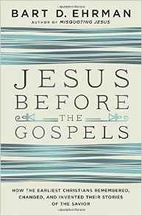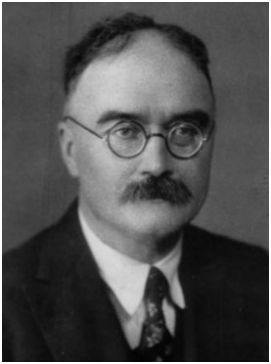 Nearly a year ago, while reading Bart Ehrman’s blog, I became aware that he was writing a book on memory. That news gave me no joy. My sense of unease, if not distress, did not diminish even when he said he had spent practically all of his spare time for two years reading up on the subject, because one never knows which Bart is going to show up.
Nearly a year ago, while reading Bart Ehrman’s blog, I became aware that he was writing a book on memory. That news gave me no joy. My sense of unease, if not distress, did not diminish even when he said he had spent practically all of his spare time for two years reading up on the subject, because one never knows which Bart is going to show up.
Will we get the Bart who writes careful, well-written, meticulously researched books (some of the best in the genre) or will we get the one who skims the surface, makes inexplicable mistakes, jumps to conclusions, and wastes our time with recycled material? Well, let’s find out.
Basic element: Maurice Halbwachs
Ehrman writes:
[Maurice] Halbwachs had a rather extreme view of how we remember. He thought that literally all of our memories are social memories, that we can’t actually have any personal, private memories, but that every memory we have is necessarily influenced by, shaped by, and provided through our various social contexts. Not everyone agrees with that view, but on one point there is much wider consensus. We—whether as individuals or as members of a collective—“remember” the past because of its value in the present. (Ehrman, 2016, Kindle Location 268, emphasis mine)
I’ll grant you that you can find social memory practitioners today who will (if only for the shock effect) flatly state, “All memory is social memory,” but Halbwachs had a much more nuanced view of the matter. As I said in a previous post, “Halbwachs differentiated between the autobiographical memory of a person and the collective memory within which individuals participate. But neither resides in a vacuum. There exists a symbiotic relationship between each type of memory.”
When we reflect on our personal memories, we rely on social frameworks — language, mores, religious beliefs, shared history, etc. — to make sense of them. On the other hand, collective memory is maintained within the personal memories of the individual minds within the group. Or, more simply: Personal memories depend on social frames for context, while social memories depend on individual brains for storage.
♦ Two Types of Memories
I will cite Halbwachs as I did when I took Ehrman to task last April:
We are not accustomed to speaking, even metaphorically, of a “group memory.” Such a faculty, it would seem, could exist and endure only insofar as it was bound to a person’s body and brain. However, suppose that remembrances are organized in two ways, either grouped about a definite individual who considers them from his own viewpoint or distributed within a group for which each is a partial image. Then there is an “individual memory” and a “collective memory.” In other words, the individual participates in two types of memory, but adopts a quite different, even contrary, attitude as he participates in the one or the other. (Halbwachs, 1980, p. 50, emphasis mine)
I wouldn’t bring up this subject again if it weren’t so crucial to Halbwachs’ understanding of collective memory and how it differs from personal memory. If you labor under the misunderstanding that Halbwachs thought “we can’t actually have any personal, private memories,” you will miss a fundamental point.
Halbwachs maintained that we actually remember things that happen to us, and that’s private memory. But when we remember the stories of things told to us about our families, groups, nation, etc., we imagine them. We recall the stories as they we were told to us, but they’re not our own.
I carry a baggage load of historical remembrances that I can increase through conversation and reading. But it remains a borrowed memory, not my own. . . . I picture them pretty much as others do. I can imagine them, but I cannot remember them. (Halbwachs, 1980, pp. 51-52, all emphasis mine)
♦ Recollection vs. Imagination

For example, Halbwachs tells us that he actually remembers Reims, because he lived there for a time. However, he also recalls various historical events that happened there.
But I also remember that Joan of Arc consecrated Charles VII there, because I have heard it said or read it. The story of Joan of Arc has been presented so often on the stage, on the movie screen, or elsewhere that I truly have no difficulty imagining Joan of Arc at Reims. (Halbwachs, 1980, p. 52, emphasis mine)
Hence, he explains, we humans have a whole library of memories in our brains that are essentially “borrowed memories.” On the other hand, we also have a set of recollections that are distinctly our own, that we experienced firsthand.
Therefore, there is reason to distinguish two sorts of memory. They might be labeled, if one prefers, internal or inward memory and external memory, or personal memory and social memory. (Halbwachs, 1980, p. 52, emphasis mine)
And finally we reach the most important, fundamental point:
If our personal memory is understood to be something that we know only from within, while the collective memory would be known only from without, then the two will surely contrast sharply. (Halbwachs, 1980, p. 52, emphasis mine)
I have been trying to drive this point home in my series on the Memory Mavens and in other general posts on social memory. We need to recognize the two different kinds of memory, and that they will have different factors that affect why we remember certain things and how we ascribe significance to certain events, people, or ideas. As I mentioned in my recent posts on memory distortion, we need to understand the processes in social memory that cause groups and societies to distort, suppress, and invent memories.
♦ The Social Construction of Maurice Halbwalchs
Now, to some degree Ehrman (pp. 213-216) seems to understand what Halbwachs was trying to say, namely that even our autobiographical memories depend on social frames. However, he still misrepresents Halbwachs by labeling his ideas as extreme (p. 213) and radical (p. 215). They may have seemed that way in the first half of the 20th century, but the notion that our understanding of the world (including our memories of it) is a social construction falls squarely in the mainstream of modern sociological thought.
Why does Ehrman hold such slanted views? He does so, because he understands Halbwachs through Barry Schwartz. As you recall, we’ve already met Schwartz and his toxic cocktail of hostility and ignorance in The Memory Mavens, Parts 3 (Bethlehem Remembered), 4 (The Analytical Power of Failure), and 5 (Rituals and Remembrance). Ehrman’s discussion of social memory theory’s origins begins with Schwartz, who leads us to Halbwachs.
Ehrman appears to have skimmed On Collective Memory (1925/1992), but is unfamiliar with his other works. In fact, the only time Ehrman cites Halbwachs from La Topographie légendaire des Evangiles en Terre sainte (1971) (tr., The Legendary Topography of the Gospels in the Holy Land), he quotes from a paper by Schwartz et al., and provides this idiosyncratic translation of the title: “On the Topography of the Gospels.”
Generally speaking, New Testament scholars who dabble in memory theory maintain a socially constructed portrait of Maurice Halbwachs whose “extreme” views must be tempered by the more “rational and sensible” Barry Schwartz. They are completely unaware that their collective memory of the great French sociologist is out of whack with the historical person. Don’t expect this state of affairs to change any time soon, because their understanding of the field and its relationship to NT studies relies entirely on this distorted memory.
Next time
In our next installment of this book review series, we’ll look at the basic element of Form Criticism. Bart invokes the names of the Formgeschichte pantheon: Karl Ludwig Schmidt, Martin Dibelius, and Rudolf Bultmann. Does he know what he’s talking about?
Ehrman, Bart D.
Jesus Before the Gospels: How the Earliest Christians Remembered, Changed, and Invented Their Stories of the Savior, Harper One, 2016
Halbwachs, Maurice
La Topographie légendaire des Evangiles en Terre sainte: étude de mémoire collective, PUF, 1971
The Collective Memory, Harper & Row, 1980
On Collective Memory, The University of Chicago Press, 1992
Tim Widowfield
Latest posts by Tim Widowfield (see all)
- How Did Scholars View the Gospels During the “First Quest”? (Part 1) - 2024-01-04 00:17:10 GMT+0000
- The Memory Mavens, Part 14: Halbwachs and the Pilgrim of Bordeaux - 2023-08-17 20:39:42 GMT+0000
- The Memory Mavens, Part 13: The Purpose of Halbwachs’s La Topographie - 2023-05-22 16:15:00 GMT+0000
If you enjoyed this post, please consider donating to Vridar. Thanks!

great, thnx for review.
I am a fan of Jesus Interrupted, Misquoting Jesus, and Forged – but I get the impression he’s been coasting on his reputation since… what I’ve seen of DJE is shockingly apologetic – has he done any good critical work after DJE?
Forgery and Counterforgery came out a few months after DJE. It’s quite good overall. Do not buy the audiobook.